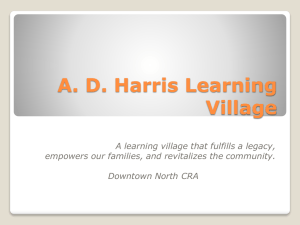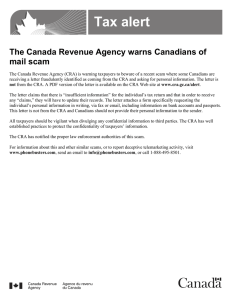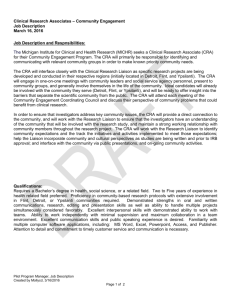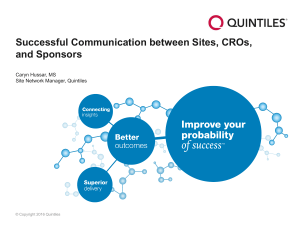Banks and Community Reinvestment
advertisement
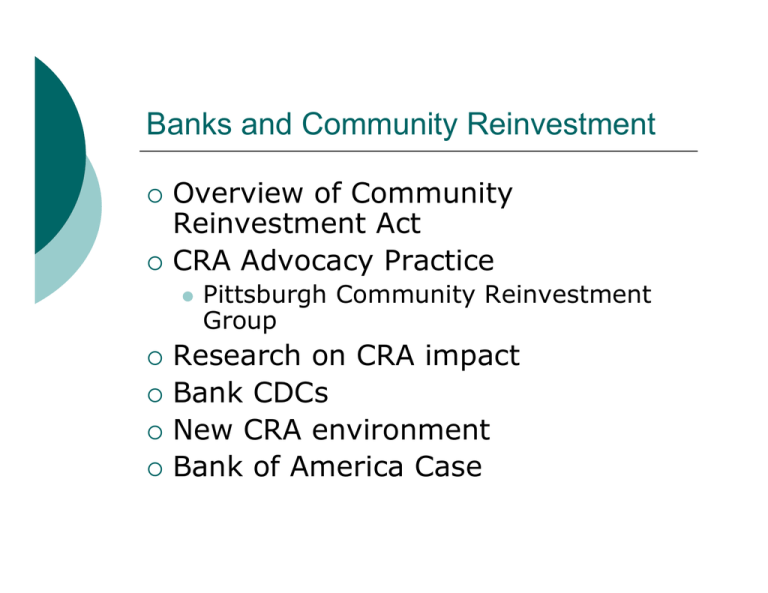
Banks and Community Reinvestment
{
{
Overview of Community
Reinvestment Act
CRA Advocacy Practice
z
{
{
{
{
Pittsburgh Community Reinvestment
Group
Research on CRA impact
Bank CDCs
New CRA environment
Bank of America Case
CRA History
{
Emerged from civil rights movement
z
z
{
Home Mortgage Disclosure Act (HMDA)
passed to address lack of enforcement
z
z
{
1968 Fair Housing Act prohibited discrimination in
the sale and rental of housing
Courts ruled that it applies to housing credit
Requires annual disclosure of home mortgage
lending by census tract in every metro area for
banks and credit unions
1989 law extended HMDA to mortgage banks and
required disclosure of mortgage applications
HMDA allowed activists to document lending
in neighborhoods to demonstrate the need for
the Community Reinvestment Act, which
congress enacted in 1977
How CRA Law Works
{
{
{
{
Requires banks to serve the banking and credit
needs of their entire service area—including LMI
households, small farms and small businesses
Banks define an assessment area that
corresponds to their service area
Regulators examine and rate banks on CRA
performance which is a public record:
Outstanding, High Satisfactory, Low Satisfactory,
Needs to Improve, Substantial Noncompliance
CRA performance is one criterion for regulators in
approving applications for various actions:
z application for FDIC insurance
z establishing a new domestic branch
z New bank charters and changes in charter
z mergers, consolidations, and acquisitions
How CRA Law Works
{
CRA reviews changed in 1995 from process- to
outcome-based via score for three tests:
z
z
z
z
{
{
{
A lending test - based on home mortgage, small
business, small farm and community development
lending
A service test - retail banking and community
development services
An investment test - other investments, grants
donations, etc. for community development purposes
Disclosure of small business and small farm lending
Frequency of CRA review based on bank size
and past ratings
Vast majority of banks receive outstanding or
satisfactory ratings
Tests do not consider race or denial rates
CRA Advocacy Practice
{
{
{
{
Community-based coalitions in cities and
states advocate for expanded bank lending
and services in low-income and minority
neighborhoods
Coalitions research lending & service
patterns, intervene in regulatory hearings,
negotiate formal CRA agreements and
monitor implementation
Banks sign CRA agreements in response to
bad publicity over past practices and to
forestall opposition to mergers/expansions
NCRC reports 428 CRA agreements for $4.2
trillion since 1977—some “double counting”
as new agreements superseded old ones.
CRA Advocacy Practice
{
{
{
{
{
Research, monitoring, publicizing information
on bank performance
Organizing campaigns, pressuring, negotiating
to desired CRA agreements
Collaboration with banks to implement
agreements, offer new products & services
and improve community reinvestment
activities
Marketing & “demand side” services need to
fully utilize expanded financing
Bank, coalition and community development
partner capacity all important
CRA Best Practices and Challenges:
Pittsburgh CRG
{
{
{
{
{
{
Long-stranding citywide CRA coalition
Early successful campaign & CRA
agreement with UNB/Integra merger
Worked with many other banks and city to
expand investment & home mortgages
What did PCRG accomplish?
Which approaches and practices struck you
most effective or innovative?
What were the most critical challenges to
its impact?
Impact of CRA on Bank Lending
{
CRA altered bank lending to LMI & minority
communities:
z
z
z
{
{
{
Banks rediscovered these markets and their profit potential
New collaborations between banks, CBOs and local
governments expanded commitment and capacity to serve
these markets
Institutionalizing special CD lending units
Bank report that CRA changed their lending
Banks with CRA agreements are more active home
mortgage lenders to low-income and minority
borrowers
CRA loans are profitable & perform well
z
z
Most banks report CRA small business and housing loans are
profitable with equal or higher returns than conventional
loans
Small business CRA loan returns on equity, delinquency and
charge-off rates are very close to conventional loans for the
vast majority of banks
Bank CDCs:
When a Bank is not a Bank
{
{
A federal regulation allows banks to make investments
and undertake activities to benefit LMI areas or advance
the public welfare that they cannot outside do
Flexible and non-bureaucratic vehicle through which
banks can undertake unusual or high-risk activities:
z
z
z
z
z
{
Limits on bank resources committed to Bank CDC:
z
z
{
High risk loans
Equity investments in firms, real estate projects, financing
entities or organizations
Direct real estate development activities
Direct consulting and technical assistance activities
Providing grants
OCC: 5% of bank capital and surplus (can be 10%)
Fed: 5% of bank capital and surplus for state banks
Mellon bank example
New CRA Environment
{
{
Bank consolidation has created superregional and national banks less tied to a
single a city or region
Banks establish their own CRA plans
z
z
{
{
Set their CRA agenda
Pre-exempt negotiation with coalitions
Increasing non-bank lending, esp. home
mortgages
Adverse regulatory and legislative posture
z
New trend toward pre-emption of state laws
